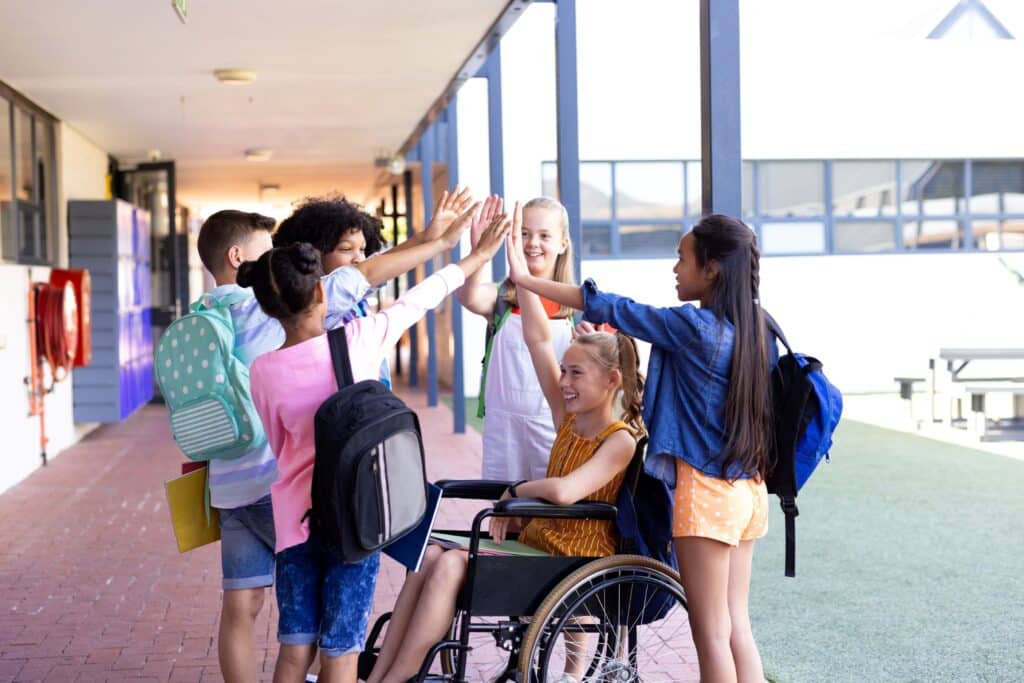Understanding Ableism in School
Education and the world have significantly changed over the last decade. Unfortunately, ableism has been around for years and continues to be a concern not only in education but also outside our educational system. It is important to understand what ableism is and how we, as educators, can build an inclusive school environment.
Ableism actually can come in a few different forms. Ultimately, ableism is discrimination against people with disabilities. This includes discrimination towards those with physical or cognitive disabilities. It may sound strange that ableism can be shown in two ways, positive and negative. Positive ableism often indicates when a student without disabilities thinks the person that is disabled needs saving or rescuing. While this may be something that doesn’t come to mind as being harsh, it can still be harmful.
In the classroom, this may look like a classmate doing all the students’ work for them or overly trying to help them when it is evident that help is unnecessary. The student without the disability often can appear to be overbearing. This often leaves the student with a disability feeling as if they are “less than” their peers, and this damages their confidence. Often, especially with our younger students who want to “help” come from a place of good intentions. Students find it difficult to understand that their thoughtfulness is seen as a negative action. As educators, we can be sure to teach our students about our classroom community and how all students are equal.
Negative ableism is often downright hostile. Students who fall victim to negative ableism are denied opportunities otherwise open to them. This can happen at home, in public, at the workplace, or even within our schools. Negative ableism is nothing short of bullying. Hostile, aggressive, and downright mean actions fall in this category. This too is something that educators can be sure does not enter in their classroom community.
Creating an Anti-Ableist Classroom
There are ways that teachers can begin from day one in avoiding ableism in their classroom. Before students even arrive, the layout of the classroom is important. Ensuring that all students, including those with disabilities, can access everything that a nondisabled peer has access to. The furniture layout and the positioning of where the students with the disability will sit is important. The students must feel included, and there shouldn’t be any type of barrier to their inclusion and being part of the classroom.
In our classrooms, we must hold expectations for all students and include all students in recreational and social events. Assumptions should not be made about any student’s limitations. We want all our students to be included and enjoy time with their peers. When assigning group work, educators should be sure to consider everyone’s role within the group. Positive interactions with proximity to all students can make the classroom teacher aware of negativity within the room. The expectation of using respectful and appropriate language also promotes a classroom community that empowers all students.
It is critical that schools provide support and accommodations for students. As teachers, we must know all sections of the student’s IEP and follow it. We are the voice for our students, and it is our responsibility to be sure that the appropriate services are in place during the school day. If a teacher recognizes that the student is not getting the necessary support needed to be successful, then the teacher must speak up to the IEP team so that ableism is avoided. We do not want any of our students falling further behind, and all students are entitled to a quality education.
Building an Inclusive School Culture
Just as it is important to build a positive classroom community, a healthy, inclusive school culture must in place. Well-thought-out plans, as well as a feasibility study, should occur routinely to ensure the layout of the building is deemed appropriate over time. A well-known form of ableism is poor building design. Schools that do not have appropriate access for students to engage in all activities anywhere on school grounds fully is a form or ableism that must be avoided. As long as school leaders stay on top of their incoming students and identify their needs, this can be completely avoided.
Going further than just the culture in our classrooms and the inclusiveness of our school, we should also consider our outdoor space as well. Playground equipment should meet the needs of all students. Sensory areas, swings with harnesses, communication boards, and inclusive play areas will allow for students to play, share excitement with their peers and gain social skills as they interact with their classmates.
Lastly, setting the tone for the entire school, including the students and the staff, is of utmost importance. Not tolerating discrimination of any type, must start from day one. A community within the school is something that can be created and should be created before the first day of school. When students have set rules and expectations in place, as well as a positive role model, modeling for them what it looks like to be accepting and respectful, this starts off the school year, decreasing the chance of ableism to occur.
Tackling ableism is an ongoing task. As educators, we have the power to prevent it from happening anywhere on school grounds. We can effectively implement these strategies in our classrooms by listening to our students, engaging with them, building rapport with them, and setting the tone of a positive culture. At the end of the day, it is our responsibility to provide the very best education to all of our students. Each one of them deserves to be treated equally and fiercely, regardless of their differences.
Educators never stop learning; check out our available graduate degree programs to hone your skills and promote lifelong learning and academic excellence.




